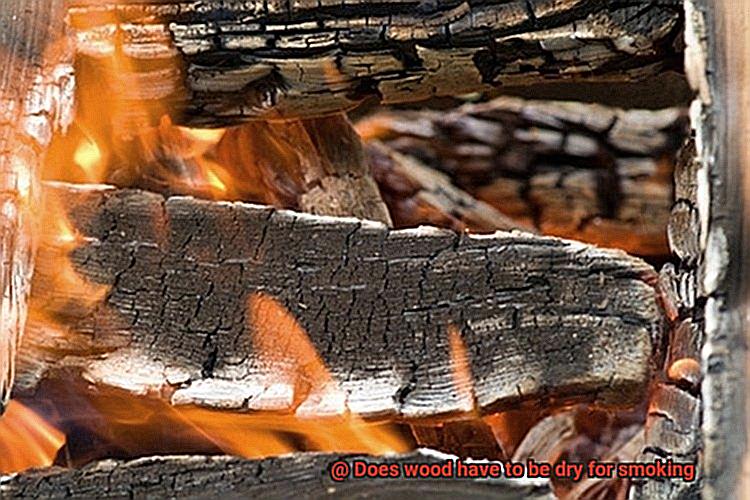Do you salivate at the thought of smoky, succulent meats? Are you a newbie to smoking meats and curious about whether wood needs to be dry before it’s used for smoking? Well, you’ve come to the right place.
Choosing the right type of wood is crucial when it comes to smoking meats. But did you know that the moisture content of the wood is just as important? So, does wood have to be dry for smoking? The short answer is yes – drier is better.
Freshly cut wood can contain up to 50% moisture, which is far too high for smoking. Wet wood produces thick, heavy smoke that can give your meat an unpleasant bitter taste. It also makes it challenging to regulate your smoker’s temperature, leading to uneven cooking or long cooking times.
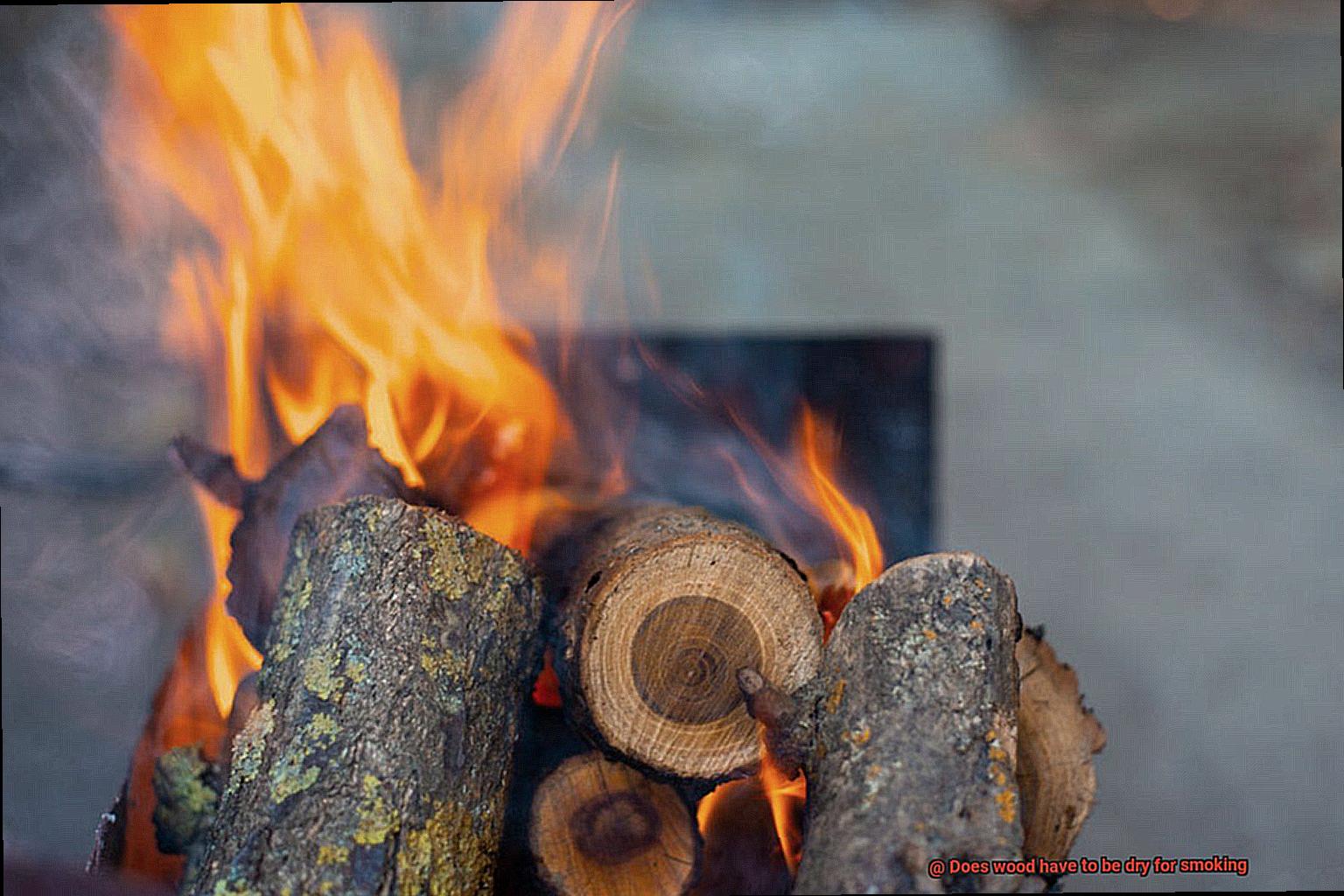
In this blog post, we’ll dive into why using dry wood is essential for smoking and the effects of using wet wood. We’ll also provide tips on how to dry your wood properly for smoking so you can enjoy mouth-watering smoked meats every time.
So let’s get started and learn about the importance of using dry wood for smoking your favorite meats.
Contents
What is Smoking Meat?
Smoking meat is an ancient cooking technique that has stood the test of time. It is a process that preserves food while enhancing its flavor by exposing it to smoke from burning wood. This imparts a unique smoky flavor to the meat, making it a favorite cooking method for many.
To smoke meat, three main components are needed: the heat source, the smoke source, and the meat. The heat source is usually a fire that generates both heat and smoke. The smoke source is the wood that adds flavor to the meat. Lastly, the meat is placed in a smoker or grill where it is exposed to the heat and smoke for an extended period of time.
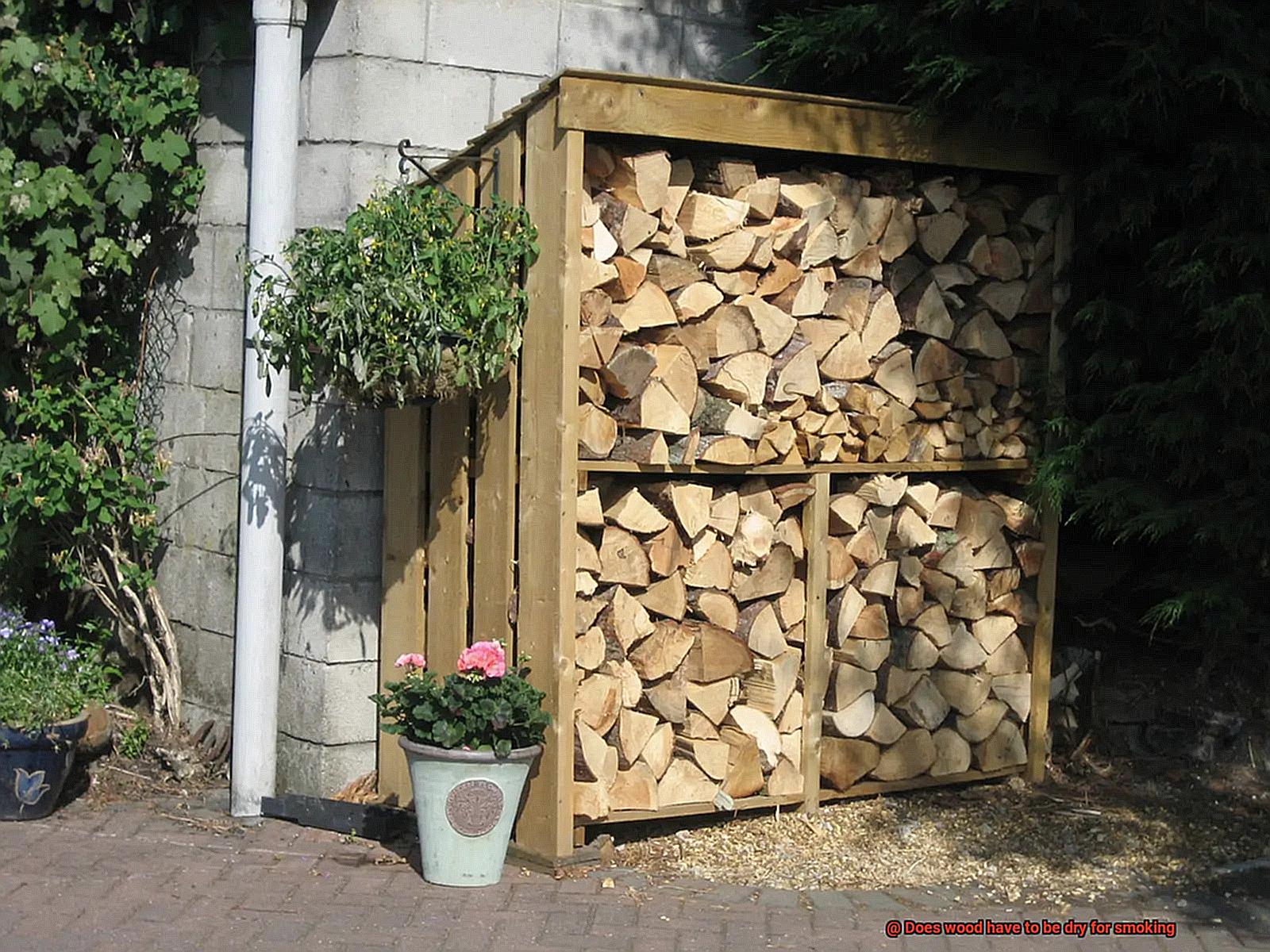
The type of wood used for smoking greatly impacts the flavor of the meat. Popular options include hickory, mesquite, applewood, and cherrywood, each with its own distinctive flavor profile that can complement or contrast with different meats. However, it’s essential to use dry wood as wet or green wood produces less smoke and may not add enough flavor to the meat.
When using wood for smoking, it’s important to store it in a dry place for at least six months to a year before use to ensure it’s fully dried out. This results in less smoke production and cleaner burning, creating mouth-watering smoked meats that will delight your taste buds.
Why Should Wood be Dry for Smoking?
Smoking meat is an intricate cooking technique that involves an art passed down from generation to generation. The kind of wood you use for smoking plays a significant role in achieving the perfect flavor and texture of smoked meat. One common question that many people ask is whether or not the wood needs to be dry before using it for smoking. As an expert on this topic, I can tell you that yes, wood should be dry before using it for smoking, and here’s why:
- Moisture Content: When wood is wet, it contains a lot of moisture that can make it difficult to get a fire started and create a lot of smoke, resulting in bitter-tasting meat. On the other hand, dry wood burns hotter and more efficiently, which means that the meat will cook more evenly and reach the desired internal temperature more quickly. Therefore, to achieve consistent heat levels and avoid bitter-tasting meat, it’s essential to use dry wood.
- Flavor: The type of wood you use for smoking significantly impacts the flavor of your meat. Dry wood produces less smoke, which results in milder and more pleasant flavors. In contrast, wet or green wood produces less smoke and may not add enough flavor to the meat. By using dry wood for smoking, you can enhance the flavors of your meat and achieve a rich smoky taste.
- Safety: Using wet or green wood for smoking increases the risk of mold growth. Wet wood provides an ideal environment for mold to grow, which can be harmful if ingested. By using dry wood, you can greatly reduce this risk and ensure that your meat is safe to eat. Therefore, it’s crucial to keep your wood dry and stored appropriately.
How to Ensure the Wood is Dry?
Smoking meat is an art that requires the right tools and techniques, and one of the most critical aspects of smoking is ensuring that your wood is dry. Wet or green wood can ruin the flavor of your meat, produce excessive smoke, and even be dangerous. To avoid these issues, here are some tips to ensure your wood is dry and ready for smoking.
Choose the Right Wood
The type of wood you select can make a big difference in the quality of your smoke. Hardwoods like oak, hickory, and mesquite are excellent choices because they have a low moisture content and burn slowly. Fruitwoods like apple and cherry also work well, providing a sweeter taste. Avoid softwoods like pine or cedar as they contain high levels of resin that can produce toxic smoke.
Proper Storage
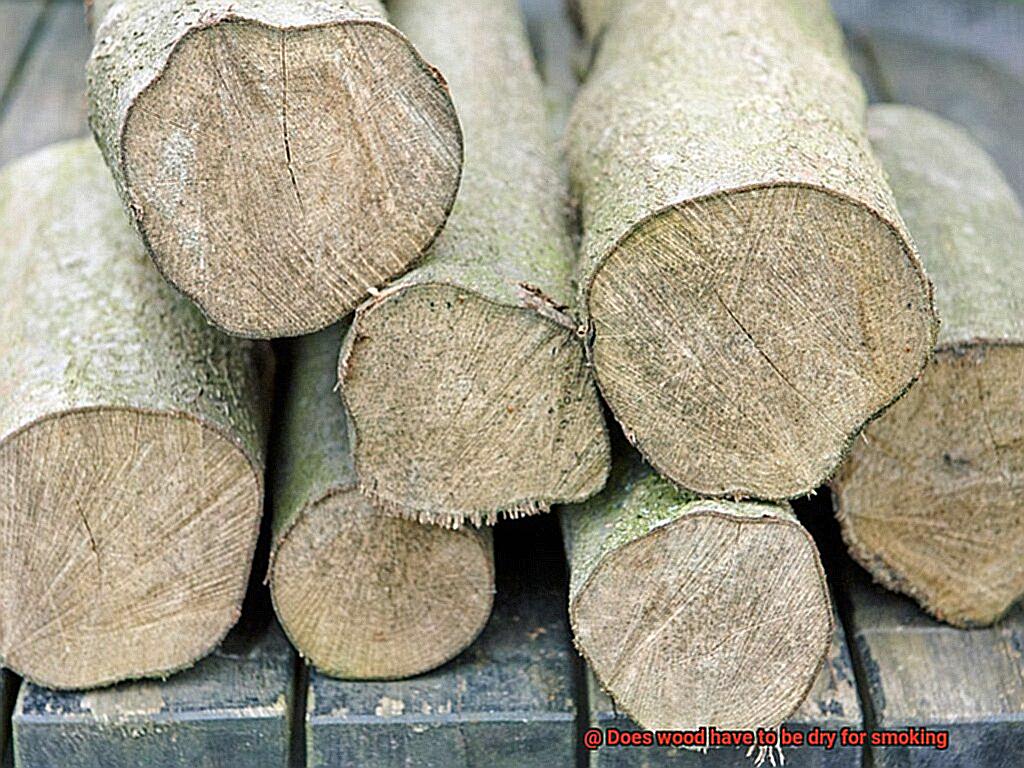
Storing your wood correctly is essential to prevent moisture buildup. Keep your wood in a dry, well-ventilated area like a shed or garage. Ensure it’s off the ground to prevent it from absorbing moisture from the soil. Cover your wood with a tarp or other waterproof material to protect it from rain or snow.
Check Moisture Content
Before using your smoking wood, check its moisture content using a moisture meter. The ideal moisture level for smoking wood should be between 10-20%. If the moisture level is higher than this, the wood needs more time to dry.
Cut into Small Pieces
Cutting your wood into small pieces allows more surface area to be exposed to air, which promotes faster drying. Splitting logs into quarter rounds or smaller will allow for better air circulation.
Check Weight
Dry wood is lighter than wet or green wood. Weigh a few pieces of wood at the beginning and then weigh them again after a few days. If the weight has decreased significantly, it means that the wood is drying out.
What Types of Wood are Ideal for Smoking?
Smoking meat is a culinary art that requires the selection of the right wood to achieve the perfect flavor. The type of wood used for smoking can make or break the final taste of your dish, and it’s crucial to choose wisely. Here are some of the best woods for smoking, along with their unique flavors and ideal meat pairings.
Hickory
Hickory is a classic hardwood that’s widely used for smoking, thanks to its bold and intense flavor. It’s perfect for beef and pork, giving your meat a smoky taste that’s not too overpowering but still packs a punch.
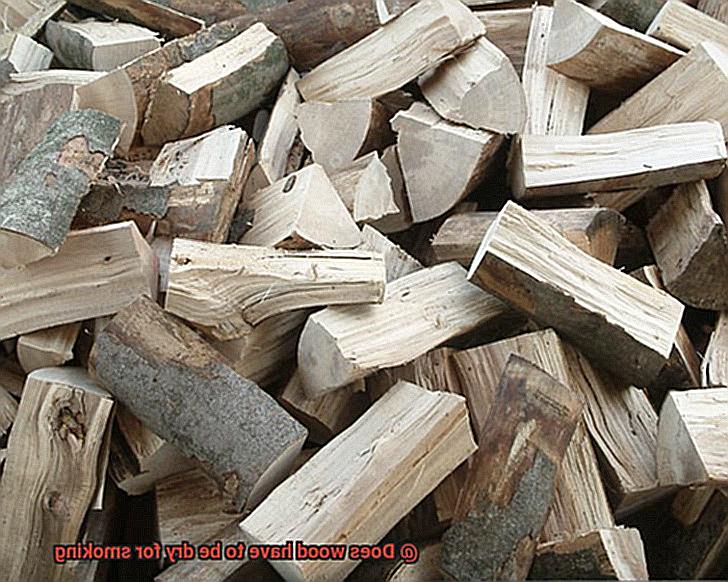
Mesquite
Mesquite is a popular choice in southwestern United States cuisine for its earthy flavor that pairs well with beef and game meats. Its intense flavor profile is not for everyone, but if you’re a fan of bold flavors, mesquite is definitely worth trying.
Apple
Applewood is a mild hardwood that’s ideal for smoking poultry and pork. It produces a sweet, fruity flavor that adds a subtle yet irresistible taste to your dishes.
Cherry
Cherrywood is another mild hardwood that’s perfect for pork, poultry, and even beef. It offers a mild and sweet flavor that’s not too overpowering but still adds depth to your dishes.
Oak
Oak is one of the most versatile woods for smoking, as it can be used with any type of meat. It has a subtle, smoky flavor that won’t dominate the taste of your meat but will deliver a pleasant smokiness.
Alder
Alderwood is a popular choice for smoking fish, particularly salmon, because of its mild and slightly sweet flavor that complements fish nicely without overpowering it.
When choosing wood for smoking, it’s important to avoid softwoods like pine or cedar as they contain resins that can give off an unpleasant flavor when burned. Hardwoods like those listed above are ideal for smoking because they burn cleaner and produce a more pleasant smoke. It’s also essential to ensure that your wood is dry before using it for smoking. Wet or damp wood produces more smoke and less heat, which can cause an unpleasant taste and even spoil the meat.
Benefits of Using Dry Wood for Smoking
When it comes to smoking meats, using dry wood can take your grilling game to the next level. Not only does it produce a consistent amount of smoke that permeates the meat evenly, but it also offers several other benefits.
Firstly, dry wood burns more efficiently than wet or green wood. This means that you won’t have to worry about uneven smoke or flare-ups that can ruin your food. Instead, you’ll be able to achieve a cleaner burn with less ash and soot residue on your food. This is especially important for longer smoking sessions as it can affect the taste and texture of your food.
But that’s not all. Dry wood also offers a more intense smoke flavor that can be adjusted based on the type of wood used. Whether you’re looking for a bold hickory flavor or a mild fruity taste from applewood or cherrywood, dry wood can help you achieve your desired flavor profile.
In addition to its flavor benefits, dry wood is also more convenient to store and transport than wet wood. Its lighter weight and easier stacking make it perfect for any grilling situation, no matter where you are.
Potential Problems with Wet or Damp Wood
If so, you may be unknowingly sabotaging your grilling game by using wet or damp wood. The moisture in the wood can lead to several potential problems that can ruin the flavor, texture, and even safety of your meat.
Firstly, the moisture in wet or damp wood can create too much steam that prevents the smoke from adhering properly to the meat. This can result in a tasteless and less-than-ideal texture that fails to deliver the desired BBQ experience. Additionally, it can create excessive smoke that overwhelms your meat and leaves an over-smoked flavor that is far from appetizing.
Moreover, using wet or damp wood can pose a safety risk because it can cause temperature fluctuations in your smoker or grill. This makes it challenging to maintain a consistent cooking temperature, which increases the risk of undercooked or overcooked meat. Such meat is potentially dangerous to eat and can make one sick.
To avoid these potential problems, it’s essential to use dry wood when smoking your meat. Dry wood ensures that the smoke adheres correctly to the meat and gives it the desired flavor and texture without overwhelming it with excessive smoke. Additionally, dry wood helps maintain a consistent cooking temperature, reducing any risk of foodborne illness.
Steps to Take if the Wood is Wet
Firstly, ensure that you store your wood in a dry place. If you have wet wood, move it to a covered porch or garage. You can also use a dehumidifier to help remove any excess moisture from the storage area.
But what if you need to use the wood right away? Here are some ways to dry it out:
- Oven: Place the damp wood in the oven at a low temperature (around 200°F) for several hours until it is completely dry.
- Smoker or Grill: Place the wood on the top rack of the smoker or grill while it’s running at a low temperature for several hours.
- Kiln or Drying Equipment: This option is more practical for larger quantities of wood and can be more efficient than using an oven or smoker.
Remember that while drying out wet wood can improve smoke quality, it cannot replace properly seasoned wood. Ideally, use dry, seasoned wood for smoking to ensure the best possible flavor and smoke quality.
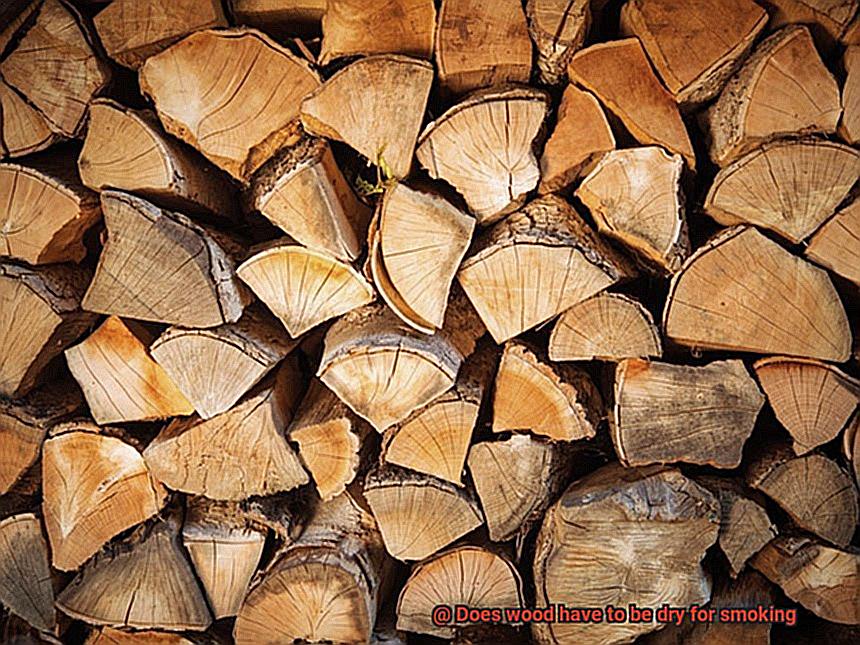
xEnwSWJwCpY” >
Conclusion
In the world of smoking meat, choosing the right wood is a crucial step in achieving the perfect flavor. The type of wood used can make or break your dish, so it’s essential to choose wisely. But there’s more to it than just selecting the right type of wood; you also need to ensure that your wood is dry.
Wet or green wood produces thick, heavy smoke that can give your meat an unpleasant bitter taste and may not add enough flavor to the meat. On the other hand, dry wood burns hotter and more efficiently, allowing your meat to cook more evenly and reach the desired internal temperature quickly. Dry wood also offers a more intense smoke flavor that can be adjusted based on the type of wood used.
To make sure your wood is dry and ready for smoking, store it in a dry place for at least six months to a year before use. Cut it into small pieces to expose more surface area to air, which promotes faster drying. Before using it for smoking, check its moisture content using a moisture meter. If the moisture level is higher than 10-20%, let it dry out further.
With these tips in mind, you’ll be able to enhance the flavors of your meat and achieve mouth-watering smoked meats every time. So go ahead and experiment with different types of dry woods like hickory for bold flavors or applewood or cherrywood for mild fruity tastes.

